Problem 1. For each of the following situations draw a graph that represents the situation. In your graph label the curve that represents the Marginal Social Cost (MSC) of producing the good, the Marginal Private Cost (MPC) of producing the good, the Marginal Social Benefit (MSB) of consuming the good, the Marginal Private Benefit (MPB) of consuming the good, the market provided quantity of the good (Qmkt), the socially optimal amount of the good (Qsoc opt), and the deadweight loss (DWL). Note that some graphs may not include each of these items.
a. Consider the market for soft drinks. Suppose recent studies show that consumption of soft drinks results in significant health costs to society due to the ingestion of high levels of high fructose corn syrup. Currently consumers of soft drinks do not take into account these health costs when determining the level of soft drinks to consume.
b. Consider the market for cars. Suppose that car manufacturers develop sophisticated robots to help in assembling cars and as a result of the spillover effect of these robots, other industries in the economy benefit from this technological improvement. Draw a graph of the car market and illustrate this spillover effect in your graph.
c. Consider the market for lobsters. Lobsters are delicious and people enjoy them immensely. However, current regulations place no restriction on the harvesting of lobsters and this leads to overharvesting of lobster from a societal point of view. Draw a graph of the lobster market and illustrate this overharvesting in your graph.
d. Consider the market for cigarettes. Cigarette smoking creates second-hand smoke which is definitely a negative consumption externality; but, cigarette smoking also results in premature death of smokers which reduces societal health care costs (a positive consumption externality). How would you analyze these two effects in the market for cigarettes and are there any conclusions you might draw from your analysis? Illustrate your analysis with a graph.
Problem 2. Consider a lighthouse that is located in a Oceanside community that is subject to gales, possesses a rocky shoreline, and often has dense fog. What is it about the lighthouse that makes it a public good? Make sure you discuss two aspects of the lighthouse that makes it a public good.
Problem 3. The other day in class I suggested that we all have a tendency to free ride. In class the examples of free riding included attending a review session without arriving with any questions (thereby free riding on your fellow students work to identify topics that should be discussed at the session), walking by the full kitchen garbage can and hoping that someone else would empty the garbage allowing you to free ride on their effort and enjoy the newly emptied can, and free riding on other people’s efforts to create a community with activities that you and your children might benefit from. Take a moment and come up with three scenarios where you have been a free rider. Be specific in your answer here. Is free riding symptomatic of the property of being non-rival or the property of being non-excludable? Defend your response.
Problem 4. The Tragedy of the Commons refers to the over use of grazing ground in England. Why did this over grazing occur? What kind of remedies could you suggest for addressing this issue now that you have studied externalities, public goods, and common resources?
Problem 5. Joey and Sarah both like to hunt deerand they hunt on public hunting land. If both Joey and Sarah hunt to their hearts’ content (no limit to the number of deer they “harvest”)Joey will get $800 worth of venison (this is the term used to describe deer meat) for his family from the hunt while Sarah will get $600 worth of venison for her family from the hunt. This amount of venison will be a one-time level since when Sarah and Joey finish hunting to their hearts’ content they will have kill all the deer in the public hunting land. If Joey hunts in a socially responsible manner (that is, he limits the number of deer he kills) while Sarah continues to hunt to her heart’s content, Joey will get $400 worth of venison while Sarah will get $300 worth of venison (we can figure that Joey is out on the land scaring off deer and making it more difficult for Sarah to successfully hunt deer). If Sarah hunts in a socially responsible manner while Joey continues to hunt to his heart’s contect, Joey will get $500 worth of venison while Sarah will get $300 worth of venison. If both Joey and Sarah hunt in a socially responsible way then Sarah will get $200 worth of venison in every hunting season while Joey will get $400 worth of venison in every hunting season for the rest of their lives (as well as their children’s lives, their grandchildren’s lives, etc. provided that all hunt in a socially responsible way). Assume that Joey and Sarah only consider the value of the venison this year when deciding how they are each going to hunt.
a. What are the two hunting choices that Joey has to choose between given the above information?
b. What are the two hunting choices that Sarah has to choose between given the above information?
c. Draw a payoff matrix illustrating the payoffs that Sarah and Joey face when considering their decision about how they plan to hunt. Put Sarah on the left hand side of the matrix and Joey on the top of the matrix. In the matrix record the payoffs as (Sarah’s payoff, Joey’s payoff) in each cell.
d. Given the above information and your analysis, what hunting choice will Joey make?
e. Given the above information and your analysis, what hunting choice will Sarah make?
f. How does this example illustrate the Prisoner’s Dilemma? Is the hunting outcome that occurs the optimal one from the perspective of Joey and/or Sarah? Explain your answer.
Problem 6. Suppose you are the President of a small country and you have decided to provide health insurance to all the residents of your country. You plan to provide this health insurance by first assessing how much money you will need to set aside per year to cover the health costs of your citizens; second, figuring out what each person would need to contribute if everyone contributed the same amount to insure that all would get health insurance coverage; third, figuring out how big a subsidy per person would need to be paid by the government in order that all could afford the health insurance; and fourth, figuring out how much more needs to be collected from the affluent in order to cover the costs of these subsidies for the lower income individuals.
Luckily you do have some information:
• The population of your country is 10 people; this population is constant over time.
• 10% of your population in any given year will have significant healthcare costs of $200,000 per person; 40% of your population in any given year will have some healthcare costs of $10,000 per person; and 50% of your population in any given year will have low healthcare costs of $2000 per person. No one in the population knows with certainty whether or not they will have significant healthcare costs, some health care costs, or low healthcare costs each year.
• You also have the following information about each individual in your country:
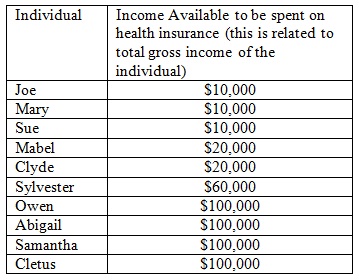
a. Given the above information calculate the amount of money you will need to collect in order to cover this year’s health care costs in your country. Use the following table to help you calculate these costs.
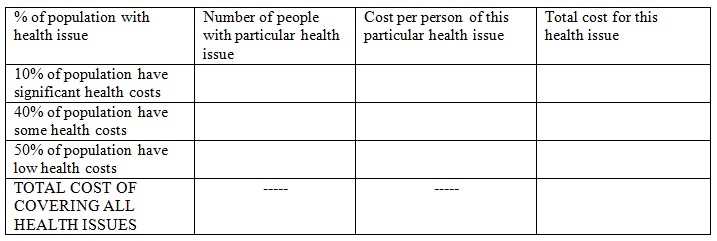
b. If everyone in the country is required to pay an equal amount for health insurance and the President wishes to collect a sufficient amount of funds to cover all health costs for the year, what payment will each individual be required to make?
c. Now that you have calculated the amount of money per person (the healthcare insurance premium) you will need to collect to cover the costs of the year’s health care, take the time to calculate how much additional money you will need to collect from the affluent in order to subsidize the lower income individuals when they go to purchase their health insurance. You will find it helpful to use the following table.
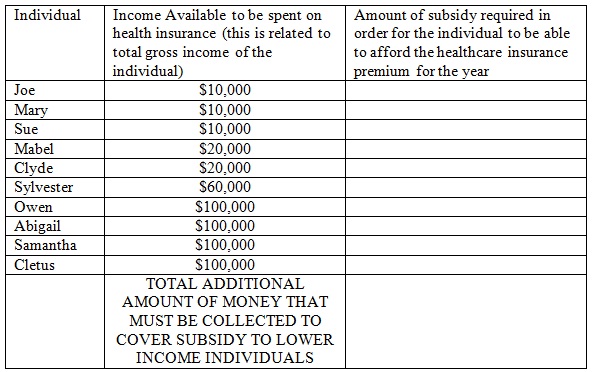
d. Suppose the cost of the healthcare insurance subsidy is divided evenly among those who can fully afford the healthcare insurance premium. What do you calculate will be the total amount per person that these individuals will need to pay for their healthcare insurance premium and their contribution to the subsidy fund? Show how you found your answer. Also fill in the following table to consolidate your work in this problem.
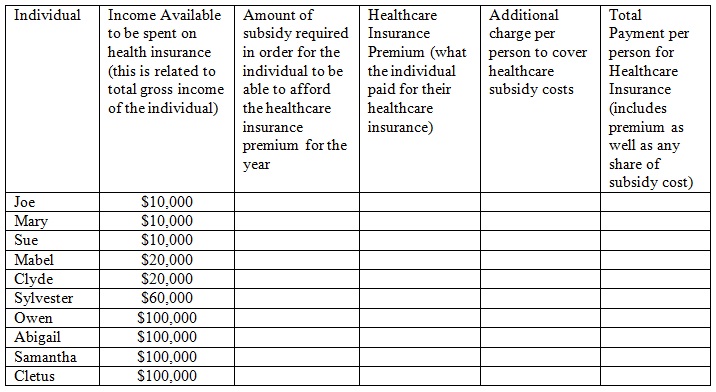
e. To further complicate this issue let’s imagine that people in this group actually know more about their healthcare situation than does the President. The following table tells us what they privately know about their healthcare situation for the coming year (assume that this information is completely accurate).
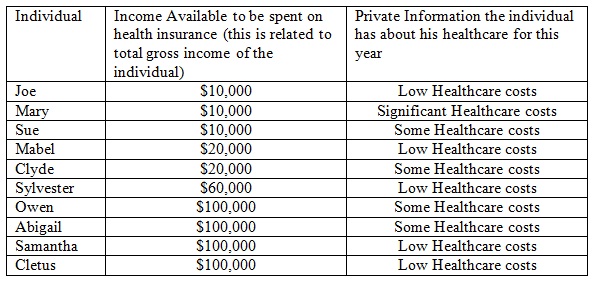
Given your answers in (b) and (d), make a prediction about whether or not each of these individuals will be willing to voluntarily pay into the healthcare pool. Assume that all individuals in this country consider only the financial costs to themselves of buying the healthcare insurance and their private healthcare information (that is, no one is altruistic in this community!). Use the following table to consolidate your predictions. Explain your answers.
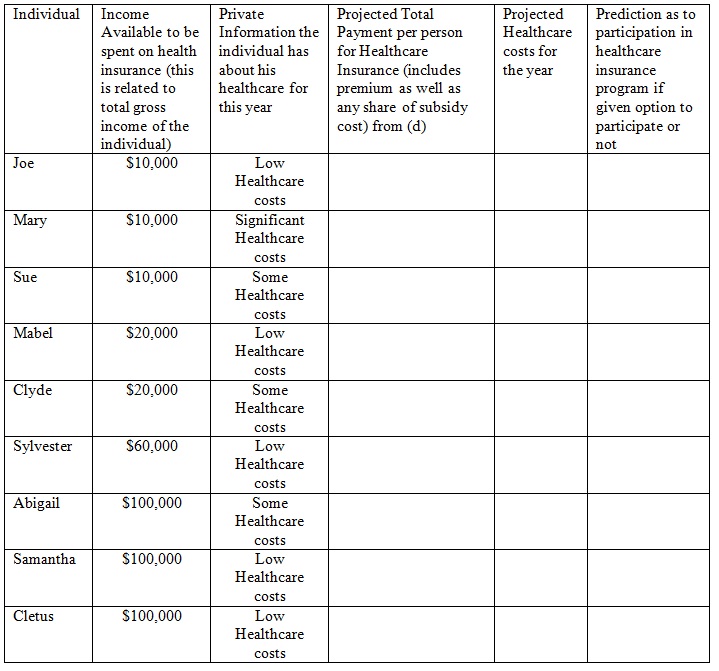
f. Given your work in this problem, provide a brief explanation of why the Affordable Care Act (“Obamacare”) includes both a subsidy for low income individuals as well as an Individual Mandate that requires everyone to purchase healthcare insurance.
Problem 7. Citizens in a small town each suffer$1 worth of irritation for each bushel of leaves that is burned in town.If the citizens haul their leaves to the town dump where they are composted there is a charge of $20 per bushel of leaves. There are 25 people living in the town, each of whom minimizetheir costs of getting rid of leaves, and each of these people has 10 bushels of leaves.
a) If there are no restrictions of any kind on burning leaves and negotiation costs among citizens are prohibitive, what will happen to the leaves in the town?
b) What is the marginal private cost of burning a bushel of leaves? What is the marginal social cost to society of burning a bushel of leaves? For each of these questions provide an explanation for how you found the answer.
c) How many dollars’ worth oftotal irritation will each person experience if all the leaves are burned? Is this the most efficient solution to this problem? Explain your answer.
d) If each leaf burner had to pay the affected citizens to cover the irritation cost that these people experience, would this lead to a different decision about whether to burn leaves or not? Explain your answer.
e) If the citizens paid a $10-per-bushel tax on each bushel burned, would this tax cause citizens to decide to haul their leaves rather than burn them? Explain the reasoning behind your answer. If the tax were $19.50 per bushel burned, would this tax cause citizens to decide to haul their leaves rather than burn them? Explain the reasoning behind your answer.
f) If you were running for mayor of the town and campaigned for a leaf-burning prohibition in the town, what do you think the response of the residents would be? That is, do you think they would vote for you?
Problem 8. A beekeeper lives adjacent to an apple orchard. The orchard owner benefits from the bees because each hive pollinates about one acre of apple trees. The orchard owner pays nothing for this service, however, because the bees come to the orchard without his having to do anything. Because there are not enough bees to pollinate the entire orchard, the orchard owner must complete the pollination by artificial means, at a cost of $10 per acre of trees.
Suppose that beekeeping has a marginal cost 10+2Q: that is, the addition to total cost to the beekeeper of maintaining an additional hive can be calculated as MPC = [(10 + 2Q) dollars], where Q is the number of beehives. Furthermore, suppose that each hive produces $20 worth of honey.
a) Use the above information and remembering the idea that one should engage in activity as long as the marginal benefit from the activity is greater than or equal to the marginal cost of that activity to calculate the optimal number of beehives the beekeeper should maintain if he only considers his own marginal costs and marginal benefits. Explain how you got your answer.
b) Is this the efficient number of hives from a societal perspective? That is, if you take into account any externality that occurs, would the socially optimal number of hives be the same as what you found in (a)? Explain your answer.
c) What changes in this scenario might you propose that would lead to the more efficient operation with regard to the number of beehives?